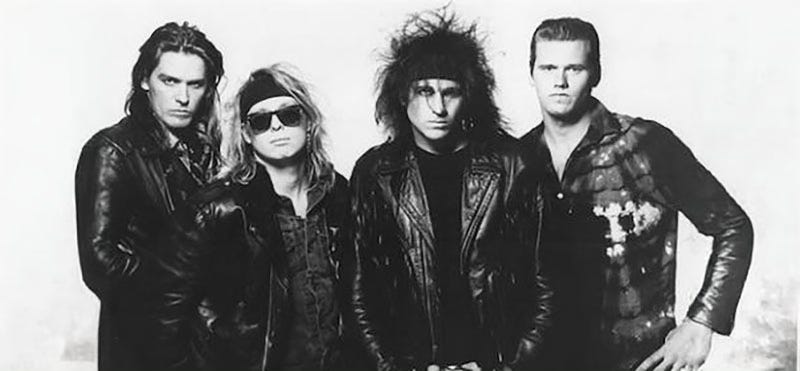TSOL
History of the Band: The Punk-Infused Metal Evolution of the 80s
TSOL, or True Sounds of Liberty, emerged from the burgeoning Southern California punk scene 1978. Formed by Jack Grisham (vocals), Ron Emory (guitar), Mike Roche (bass), and Todd Barnes (drums), the band quickly became a staple in the punk underground. Drawing initial influences from the raw energy of punk bands like the Sex Pistols and the Damned, TSOL distinguished themselves with a more theatrical, gothic approach, which would later become a defining characteristic of their sound.
Happy we’re shining a light on this band? 🫙 Say thanks with a tip! →
Musical Style and Evolution
The band’s early work was rooted in hardcore punk, particularly their self-titled EP released in 1981. However, TSOL’s sound was never static; it continuously evolved, experimenting with horror punk and gothic rock elements. Their 1981 full-length debut, “Dance with Me,” showcased this blend, featuring dark, brooding lyrics and a haunting musical style that set them apart from their contemporaries.
As the 1980s progressed, TSOL’s music incorporated more metal influences. This evolution was evident in albums like “Beneath the Shadows” (1983), which introduced keyboards and more complex song structures, signaling a shift towards a more melodic and expansive sound.
Discography and Notable 80s Albums
TSOL’s discography from the 1980s is a testament to their musical journey, marked by significant albums that reflect their evolving style.
“Dance with Me” (1981): Released by Frontier Records, this album is a cornerstone of TSOL’s early sound. Tracks like “Code Blue” and “Silent Scream” epitomize their gothic punk style. Thom Wilson produced the album, which received critical acclaim for its dark, atmospheric quality and has since become a cult classic.
“Weathered Statues” EP (1982): This EP, also released on Frontier Records, continued to build on the band’s gothic punk foundation. It features tracks like “Weathered Statues” and “Word Is,” showcasing a darker, more mature sound.
“Beneath the Shadows” (1983): Released on Alternative Tentacles, this album marked a significant shift with the addition of keyboardist Greg Kuehn. Songs like “Soft Focus” and “Glass Streets” demonstrated a more melodic and introspective approach, blending punk energy with gothic and new wave elements. The album produced by Chris D. of the Flesh Eaters showcased a band unafraid to explore new musical territories.
“Change Today?” (1984): After a brief hiatus and lineup changes, including Joe Wood taking over vocal duties from Grisham, TSOL returned with a more rock-oriented sound. Released on Enigma Records, this album featured standout tracks like “Black Magic” and “Red Shadows,” blending punk roots with a heavier, more polished sound. Howard Benson's production brought a new clarity and depth to their music.
“Revenge” (1986): TSOL fully embraced a hard rock and metal sound with this album, also on Enigma. Tracks like “No Time” and “Revenge” displayed a muscular, riff-driven approach, further distancing themselves from their punk origins. Howard Benson's production emphasized a powerful, radio-friendly sound.
“Hit and Run” (1987): Continuing their hard rock trajectory, this album, also released by Enigma Records, featured tracks like “Good Mornin’ Blues” and “Nothin’ for You.” Howard Benson produced the album, which highlighted the band’s commitment to a heavier sound.
“Live” (1988): This live album, released by Restless Records, captured the raw energy of TSOL’s performances. It included live renditions of fan favorites from their early punk days and more recent hard rock material. The album showcased the band’s dynamic stage presence and ability to connect with live audiences.
Eric Peterson suggested this artist for a future Dig Me Out podcast episode. Each month, our Patrons are presented with a selection of albums suggested by listeners and asked to vote for their favorite.
Influence and Legacy
TSOL’s work throughout the 1980s received mixed but generally positive reviews. Early albums like “Dance with Me” were praised for their originality and dark aesthetic. Critics lauded the band’s willingness to experiment and evolve, even if some fans were divided over their stylistic shifts.
“Change Today?” and “Revenge” received recognition for their polished production and accessibility. Publications like Kerrang! and Rolling Stone acknowledged the band’s growth and adaptability, even if some punk purists lamented the move towards a more mainstream rock sound.
TSOL’s impact on the punk and gothic rock scenes is undeniable. They influenced many artists, from goth pioneers like Christian Death to punk rock bands like AFI. Their blend of punk aggression with gothic and metal elements paved the way for the emergence of the Deathrock subgenre.
After the 1980s, members of TSOL pursued various musical endeavors. Jack Grisham, for instance, went on to form bands like Cathedral of Tears and The Joykiller, continuing to explore his eclectic musical interests. The band’s influence can also be seen in the resurgence of gothic and horror punk in the 1990s and beyond.
Conclusion
TSOL’s journey through the 1980s is a compelling musical evolution and experimentation story. From their punk roots to their gothic and metal-infused later works, the band consistently pushed the boundaries of their sound. While they may not have achieved the mainstream success of some of their contemporaries, their legacy is a vital piece of the larger narrative of 80s and early 90s music. TSOL remains a band that defied easy categorization, impacting the punk, gothic, and metal scenes.
By exploring their discography and the changes they underwent, fans can appreciate TSOL as a band and a dynamic force in the music world of the 1980s. Their story is of resilience, innovation, and the relentless pursuit of musical expression.



